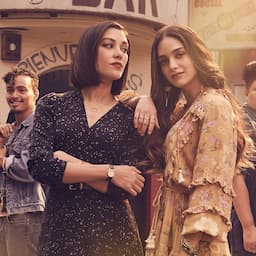Series creator Tanya Saracho, actors Tonatiuh, Melissa Barrera and Mishel Prada discuss the show's take on a quinceañera.
A quinceañera is a right of passage for many young girls in Latin America and the U.S.
When a girl turns 15, it is customary for the family to throw a massive coming-of-age celebration, complete with a big, poofy dress, giant cake, chambelanes and a special dance. The event marks the transition from childhood to womanhood in a lavish way. Sunday's episode of Vida, however, took a spin on the traditional party, throwing a "queerceañera" -- a quince-inspired celebration for a queer individual -- straight out of an '80s telenovela.
Inspired by the 1987 soap opera Quinceañera, starring Thalía and Adela Noriega, series creator Tanya Saracho also looked to Chayanne's classic 1991 track, "Tiempo de Vals," as a source for how the birthday extravaganza would look like.
"When I was writing it, I was writing the action for it and I was listening to 'Tiempo de Vals,'" Saracho tells ET during a phone conversation. "We threw it back, back, back. It wasn't like current quinceañeras. We went back."
Saracho's idea for a queerceañera came up during production for season 2, beginning with a discussion for a "double quince" (instead of celebrating turning 15, they double it and celebrate a 30th birthday). After finding out that the third season would be their last, Saracho wrote down everything she wanted to do in the final episodes. When she couldn't find the right character to have a double quince, she looked to Lyn's best friend, Marcos (played by Tonatiuh aka Tona), for a queerceañera, with one of the writers coining the term.
"It all just came together. As soon as we gave it to Marcos, it became bigger than it would've been for Lyn or Emma," Saracho notes, adding, "It had like a two-year gestation period."
Marcos' big entrance begins with him dressed in a glamorous teal gown, heels and full hair and makeup, sitting on a decorated swing as "Tiempo de Vals" starts playing. (See the epic entrance in the video above.)
For Marcos, aside from celebrating his 30th birthday, his queerceañera was also a moment where he decided to break free. "It's a right of passage that little Marcitos only dreamed of," Marcos says in his prayer group with his friends all dressed in chameblan fierceness. Later on during the party, he decolonizes his name, his gender, and dubs himself "the prince of flowers, song and dance," before taking on the name Xochipilli.
"We wanted this to be camp and there was a big moment for quinceañeras in the late '80s, early '90s, where the whole aesthetic was the chambelanes were in military attire with epaulettes, and the dresses were big," Saracho details, adding that she got the swing idea from the telenovela Quinceañera. "The Chayanne song was so big [at the time] and we wanted to have a campy double quince. We talked about it in the writers' room that Marcos grew up with pictures on the walls of his tias' [quinceañeras], with pictures of '80s hairdos and giant blue dresses and all the fake flowers around the place. He is sort of replicating a version of that."
Chayanne's "Tiempo de Vals" is a quinceañera classic with many young girls choosing the waltz-like song as their first dance. And while it serves as the perfect tune to be incorporated into Vida's episode, Chayanne's music video only cemented the need for it.
"When [Tanya] was writing season 3, I remember she sent us the music video, and the video is epic," Melissa Barrera recalls to ET. "I don't know if you've seen the video. It's hilarious. It's old and weird, and also amazing and queer! Are they nutcrackers toys, are they human, are they animals? You don't know what is going on. I think it was that that made her want to put it on Vida and it was just amazing!"
Saracho noted that Chayanne's video inspired the party "in part," adding, "'Tiempo de Vals,' it's the most!...He's dressed as a medieval king, he's dressed as restoration England. It's amazing. I took that sort of military look [for what] the chambelanes would dress like...I had 'Tiempo de Vals' on and I would write the scene and I knew exactly what I wanted the dancing to look like. And then I got to direct it, so it looked exactly how I wanted it to look like."
As for Tonatiuh, he told ET that he had a huge smile on his face, imagining the epic event during the episode's first table read. After the costume department found a traditional dress in his size in a Boyle Heights bridal and quinceañera store, Tona realized that the queerceañera was much more than a party when the gown was "strapped on to me."
"I had the heels on, the hair, the makeup, down to the hard part in my hair, and we were on set and I sat on the swing, then it really hit me. The importance of what I was doing," Tona recalls. "As a 5-year-old kid, I would sneak into my aunt's room, lock the door and put on a couple of dresses and just live in that fantasy. It had nothing to do with queerness, necessarily, it had more so to do with the exploration of fun and then later on being told that’s not OK."
Vida is one of many Latinx shows that has pushed the envelope and effortlessly incorporated LGBTQ characters and storylines, at a time when the Latinx community continues to deal with toxic masculinity and machismo.
"We’re now living in a moment where any form of self-expression is amazing and encouraged," Tona continues. "We’re really fulfilling all the prophecies that America, for instance, is a land of the free and it’s what freedom looks like for Marcos, and what freedom looks like for a lot of queer-identifying Latinx people. And for me, it just hit me, I felt like a princess."
"Giving a queerceañera for someone, a young boy who wanted to have a quinceañera but it wasn't culturally appropriate, [is amazing]," Mishel Prada tells ET. "Now he's giving himself a quinceañera. That comes back to self-empowerment."
"This being broadcast by a major network is the biggest signaling to any queer person -- especially a cis-male, queer boy -- that who you are is perfect, it is enough and you deserve to be seen," Tona notes. "It seems so small. How could one party, how could one dress have that level of impact? But because we’ve never seen ourselves presented in that way -- me as a person would want to go to that party -- being able to see ourselves like that and being glorified and being welcomed for our uniqueness is in and of itself both, I’m sorry this has taken so long and please continue being who you are because we love it."
Tona also couldn't help but praise Saracho's "perfect" iconography for the entire event. From the swing set to the song choice, Tona only reiterated the general Latinx culture's idea of a classic quince.
"'Tiempo Del Vals' is a classic song, clearly. Every quinceañera has it without a doubt, but also the swing set and everything reminded me of classic telenovela quinceañera as well," he notes, before explaining that oftentimes in Latinx cultures, men don't get celebrated in the same way. "There’s other ways they celebrate men that we won’t go through. There’s not a way of celebrating your femininity, and so for me, it was a moment of like, 'You’re free girl, fly!'"
For Tona, the queerceañera is the perfect example of "someone -- as brave as Marcos, who has chosen to travel and transcend the binary -- really letting people know this is who I am and this is how I am. Unapologetically. And I think that’s what Vida does really well, it's unapologetic."
And once Saracho knew she was going ahead with a double queerceañera, she knew it was important to showcase a non-traditional one. "I wanted to reclaim a quinceañera, and he said it, 'Little Marcitos would never have dreamed this right of passage,'" the creator explains. "It's promised to women and not to boys and why shouldn't it be? We're reenvisioning it and his bestie is the one that's walking him down and protecting him. You see this beautiful waltz that [Marcos and Lyn] did perfectly every time. I loved watching them rehearse it. And then it turns to ratchet ballroom [laughs]."
Quinceañera and "Tiempo de Vals" may have all been a source of inspiration for Saracho and her crew. But the recuerdos that they made on set and the significance of the queerceañera only made the episode and storyline even more fulfilling for the team.
"It was amazing. It was so much fun," Barrera shares about filming the party. "It was one of the most fun days on set this season. When we were shooting the dance outside, in the back part, we had so much fun. It was actually like we were at a party, it didn't feel like we were shooting anything. It just felt like we were at this queerceañera, everyone looked amazing."
And if there's one thing that Tona would like to add it's, "To all the 5-year-old boys out there, wearing their aunt's dresses in secret: You’re seen. You’re beautiful. Keep being you."
Vida airs Sundays at 9 p.m. PT/ET on Starz.
RELATED CONTENT:



